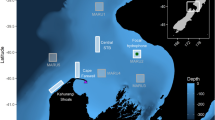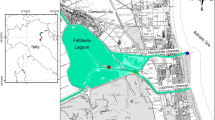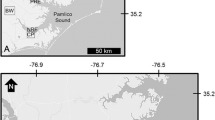Abstract
Ecosystem-based management requires integrated physical studies on biological functions. In this study, we hypothesized that seasonal variation in upwelling-favorable winds has differential influences on species of the central California Current pelagic ecosystem. To test this hypothesis, we developed multivariate indicators of upwelling and species’ responses using wind and sea surface temperature (SST) data from buoys and growth and reproductive data for 11 species of fish and seabirds. From previous work, we predicted that winds and SST could be decomposed into winter and spring/summer ‘modes’ of variability, but only a single mode of “winter/spring” environmental variability was observed. We attribute this difference from expectations to the local and shorter-term measurements of winds and SST used in this study. Most species responded to winds and SST variability similarly, but SST was a better predictor of most biological responses. Both SST and wind were better predictors than the traditional upwelling index. Notably, Pacific sardine (Sardinops sajax) was disassociated with the other biotic measurements and showed no relationships with coastal upwelling. The multivariate indicators developed here are particularly appropriate for integrated ecosystem assessments of climatic influences on marine life because they reflect both structure and processes (upwelling and timing/growth/productivity) known to determine functions in marine ecosystems.







Similar content being viewed by others
References
Abraham CL, Sydeman WJ. 2004. Ocean climate, euphausiids and auklet nesting: inter-annual trends and variation in phenology, diet and growth of a planktivorous seabird, Ptychoramphus aleuticus. Mar Ecol Prog Ser 274:235–50.
Abraham CL, Sydeman WJ. 2006. Prey-switching by Cassin’s auklet Ptychoramphus aleuticus reveals seasonal climate-related cycles of Euphausia pacifica and Thysanoessa spinifera. Mar Ecol Prog Ser 313:271–83.
Andrewartha HG, Birch LC. 1954. The distribution and abundance of animals. Chicago: University of Chicago Press. 782 pp.
Bakun A. 1973. Coastal upwelling indices, west coast of North America, 1946–71. NOAA Technical Report, NMFS SSRF-671. 141 pp.
Bakun A. 1990. Global climate change and intensification of coastal ocean upwelling. Science 247:198–201.
Bakun A, Field DB, Redondo-Rodriguez A, Weeks SJ. 2010. Greenhouse gas, upwelling-favorable winds, and the future of coastal ocean upwelling ecosystems. Glob Change Biol 16:1213–28.
Black BA, Boehlert GW, Yoklavich MM. 2005. Using tree-ring crossdating techniques to validate age in long-lived fishes. Can J Fish Aquat Sci 62:2277–84.
Black BA, Boehlert GW, Yoklavich MM. 2008. Establishing climate–growth relationships for yelloweye rockfish (Sebastes ruberrimus) in the northeast Pacific using a dendrochronological approach. Fish Oceanogr 17:368–79.
Black BA, Schroeder ID, Sydeman WJ, Bograd SJ, Lawson PW. 2010. Wintertime ocean conditions synchronize rockfish growth and seabird reproduction in the central California Current ecosystem. Can J Fish Aquat Sci 67:1149–58.
Black BA, Schroeder ID, Sydeman WJ, Bograd SJ, Wells BK, Schwing FB. 2011. Winter and summer upwelling modes and their biological importance in the California Current Ecosystem. Glob Change Biol 17:2536–45.
Bograd SJ, Schroeder I, Sarkar N, Qiu XM, Sydeman WJ, Schwing FB. 2009. Phenology of coastal upwelling in the California Current. Geophys Res Lett 36:L01602.
Botsford LW, Castilla JC, Peterson CH. 1997. The management of fisheries and marine ecosystems. Science 277:509–15.
Burrows MT, Schoeman DS, Buckley LB, Moore P, Poloczanska ES, Brander KM, Brown C, Bruno JF, Duarte CM, Halpern BS, Holding J, Kappel CV, Kiessling W, O’Connor MI, Pandolfi JM, Parmesan C, Schwing FB, Sydeman WJ, Richardson AJ. 2011. The pace of shifting climate in marine and terrestrial ecosystems. Science 334:652–5.
Capet XJ, Marchesiello P, McWilliams JC. 2004. Upwelling response to coastal wind profiles. Geophys Res Lett 31:L13311.
Chavez FP, Messié M. 2009. A comparison of Eastern Boundary Upwelling Ecosystems. Prog Oceanogr 83:80–6.
Checkley DM Jr, Barth JA. 2009. Patterns and processes in the California Current System. Prog Oceanogr 83:49–64.
Cury PM, Shin YJ, Planque B, Durant JM, Fromentin JM, Kramer-Schadt S, Stenseth NC, Travers M, Grimm V. 2008. Ecosystem oceanography for global change in fisheries. Trends Ecol Evol 23:338–46.
Dever EP, Lentz SJ. 1994. Heat and salt balances over the northern California shelf in winter and spring. J Geophys Res 99:16001–17.
Di Lorenzo E, Schneider N, Cobb KM, Franks PJS, Chhak K, Miller AJ, McWilliams JC, Bograd SJ, Arango H, Curchitser E, Powell TM, Riviere P. 2008. North Pacific Gyre Oscillation links ocean climate and ecosystem change. Geophys Res Lett 35:L08607.
Doney SC, Ruckelshaus M, Duffy JE, Barry JP, Chan F, English CA, Galindo HM, Grebmeier JM, Hollowed AB, Knowlton N, Polovina J, Rabalais NN, Sydeman WJ, Talley LD. 2012. Climate change impacts on marine ecosystems. Annu Rev Mar Sci 4:11–37.
Field JC, MacCall AD, Bradley W, Sydeman WJ. 2010. Estimating the impacts of fishing on dependent predators: a case study in the California Current. Ecol Appl 20:2223–36.
Frederiksen M, Mavor RA, Wanless S. 2007. Seabirds as environmental indicators: the advantages of combining data sets. Mar Ecol Prog Ser 352:205–11.
García-Reyes M, Largier JL. 2010. Observations of increased wind-driven coastal upwelling off central California. J Geophys Res 115:C04011.
García-Reyes M, Largier JL. 2012. Seasonality of coastal upwelling off central and northern California: new insights, including temporal and spatial variability. J Geophys Res 117:C03028.
Halpern BS, Walbridge S, Selkoe KA, Kappel CV, Micheli F, D’Agrosa C, Bruno JF, Casey KS, Ebert C, Fox HE, Fujita R, Heinemann D, Lenihan HS, Madin EM, Perry MT, Selig ER, Spalding M, Steneck R, Watson R. 2008. A global map of human impact on marine ecosystems. Science 319:948–52.
Hemery G, D’Amico F, Castege I, Dupont B, D’Elbee J, Lalanne Y, Mouches C. 2008. Detecting the impact of oceano-climatic changes on marine ecosystems using a multivariate index: the case of the Bay of Biscay (North Atlantic-European Ocean). Glob Change Biol 14:27–38.
Hill KT, Lo N, Macewicz B, Crone P, Felix-Uraga R. 2010. Assessment of the Pacific sardine resource in 2010 for US management in 2011. NOAA Southwest Fisheries Science Center. November 2010.
Holt CA, Mantua NJ. 2009. Defining spring transition: regional indices for the California Current System. Mar Ecol Prog Ser 393:285–97.
Iles AC, Gouhier TC, Menge BA, Stewart JS, Haupt AJ, Lynch MC. 2012. Climate-driven trends and ecological implications of event-scale upwelling in the California Current System. Glob Change Biol 18:783–96.
Jackson JBC, Kirby MX, Berger WH, Bjorndal KA, Botsford LW, Bourque BJ, Bradbury RH, Cooke R, Erlandson J, Estes JA, Hughes TP, Kidwell S, Lange CB, Lenihan HS, Pandolfi JM, Peterson CH, Steneck RS, Tegner MJ, Warner RR. 2001. Historical overfishing and the recent collapse of coastal ecosystems. Science 293:629–38.
Jacox MG, Edwards CA. 2011. Effects of stratification and shelf slope on nutrient supply in coastal upwelling regions. J Geophys Res 116:C03019.
Jolliffe IT. 2002. Principal component analysis. 2nd ed. Springer series in statistics. ISBN 0-387-95442-2.
Koslow JA, Goericke R, Lara-Lopez A, Watson W. 2011. Impact of declining intermediate-water oxygen on deepwater fishes in the California Current. Mar Ecol Prog Ser 436:207–18.
Lack D. 1954. The natural regulation of animal numbers. London: Oxford University Press.
Large WG, Pond S. 1981. Open ocean momentum flux measurements in moderate to strong winds. J Phys Oceanogr 11:324–36.
Levin PS, Fogarty MJ, Murawski SA, Fluharty D. 2009. Integrated ecosystem assessments: developing the scientific basis for ecosystem-based management of the ocean. Public Library of Science Biology 7:e1000014.
Logerwell EA, Mantua N, Lawson PW, Francis RC, Agostini VN. 2003. Tracking environmental processes in the coastal zone for understanding and predicting Oregon coho (Oncorhynchus kisutch) marine survival. Fish Oceanogr 12:554–68.
Love MS, Yoklavich M, Thorsteinson L. 2002. The rockfishes of the Northeast Pacific. Berkeley and Los Angeles: University of California Press.
Mann KH. 2000. Ecology of coastal waters, with implications for management. 2nd edn. Malden: Blackwell Science.
Mantua NJ, Hare SR. 2002. The Pacific Decadal Oscillation. J Oceanogr 58:35–44.
May RM, Beddington JR, Clark CW, Holt SJ, Laws RM. 1979. Management of multispecies fisheries. Science 205:267–76.
Moloney CL, St. John MA, Denman KL, Karl DM, Koster FW, Sundby S, Wilson RP. 2011. Weaving marine food webs from end to end under global change. J Marine Syst 84:106–11.
Narayan N, Paul A, Mulitza S, Schulz M. 2010. Trends in coastal upwelling intensity during the late 20th century. Ocean Sci Discuss 7:335–60.
Nur N, Sydeman WJ. 1999. Survival, breeding probability and reproductive success in relation to population dynamics of Brandt’s cormorants Phalacrocorax penicillatus. Bird Study 46(Suppl):S92–103.
Pauly D, Christensen V. 1995. Primary production required to sustain global fisheries. Nature 374:255–7.
Pena MA, Bograd SJ. 2007. Time series of the northeast Pacific. Prog Oceanogr 75:115–19.
Pickett MH, Schwing FB. 2006. Evaluating upwelling estimates off the west coasts of North and South America. Fish Oceanogr 15:256–69.
Pikitch EK, Santora C, Babcock EA, Bakun A, Bonfil R, Conover DO, Dayton P, Doukakis P, Fluharty D, Heneman B, Houde ED, Link J, Livingston PA, Mangel M, McAllister MK, Pope J, Sainsbury KJ. 2004. Ecosystem-based fishery management. Science 305:346–7.
Rice JC, Rochet MJ. 2005. A framework for selecting a suite of indicators for fisheries management. ICES J Mar Sci 62:516–27.
Rosenfeld LK, Schwing FB, Garfield N, Tracy DE. 1994. Bifurcated flow from an upwelling center: a cold water source for Monterey Bay. Cont Shelf Res 14:931–64.
Rykaczewski RR, Checkley DM Jr. 2008. Influence of ocean winds on the pelagic ecosystem in upwelling regions. Proc Natl Acad Sci USA 105:1965–70.
Schroeder ID, Sydeman WJ, Sarkar N, Thompson SA, Bograd SJ, Schwing FB. 2009. Winter pre-conditioning of seabird phenology in the California Current. Mar Ecol Prog Ser 393:211–23.
Schwing FB, O’Farrell M, Steger JM, Baltz K. 1996. Coastal upwelling indices, west coast of North America, 1946–95. NOAA Technical Report NOAA-TM-NMFS-SWFSC-231, pp. 32
Schwing FB, Murphree T, Green PM. 2002. The Northern Oscillation Index (NOI): a new climate index for the northeast Pacific. Prog Oceanogr 53:115–39.
Smith PE, Moser HG. 2003. Long term trends and variability in the larvae of Pacific sardine and associated fish species of the California Current region. Deep-Sea Res II 50:2519–36.
Solomon S, Qin D, Manning M, Chen Z, Marquis M, Averyt KB, Tignor M, Miller HL. 2007. Climate change 2007: The physical science basis. Contribution of Working Group I to the Fourth Assessment Report of the Intergovernmental Panel on Climate Change. Cambridge: Cambridge University Press.
Strom L, Tjernstrom M. 2004. Variability in the summertime coastal marine atmospheric boundary-layer off California, USA. Q J Roy Meteorol Soc 130:423–48.
Sydeman WJ, Hobson KA, Pyle P, McLaren EB. 1997. Trophic relationships among seabirds in central California: combined stable isotope and conventional dietary approach. Condor 99:327–36.
Sydeman WJ, Hester MM, Thayer JA, Gress F, Martin P, Buffa J. 2001. Climate change, reproductive performance and diet composition of marine birds in the southern California Current system, 1969–1997. Prog Oceanogr 49:309–29.
Sydeman WJ, Mills KL, Santora JA, Thompson SA, Bertram DF, Morgan KH, Wells BK, Hipfner JM, Wolf SG. 2009. Seabirds and climate in the California Current—a synthesis of change. Calif Coop Ocean Fish Investig Rep 50:82–104.
Thayer JA. 2009. Rhinoceros auklet reproduction, survival and diet in relation to ocean climate. Ph.D. Dissertation. University of California, Davis.
Thayer JA, Sydeman WJ. 2007. Spatio-temporal variability in prey harvest and reproductive ecology of a piscivorous seabird, Cerorhinca monocerata, in an upwelling system. Mar Ecol Prog Ser 329:253–65.
Thompson JE, Hanna RW. 2010. Using cross-dating techniques to validate ages of aurora rockfish (Sebastes aurora): estimates of age, growth and female maturity. Environ Biol Fishes 88:377–88.
Thompson SA, Sydeman WJ, Santora JA, Black BA, Suryan RM, Calambokidis J, Peterson WT, Bograd SJ. 2012. Linking predators to seasonality of upwelling: using food web indicators and path analysis to infer trophic connections. Prog Oceanogr 101:106–20.
Vander Woude AJ, Largier JL, Kudela KM. 2006. Nearshore retention of upwelled waters north and south of Point Reyes (northern California). Deep-Sea Res II 53:2985–98.
Wells BK, Grimes CB, Waldvogel JB. 2007. Quantifying the effects of wind, upwelling, curl, sea surface temperature and sea level height on growth and maturation of a California Chinook salmon (Oncorhynchus tshawytscha) population. Fish Oceanogr 16:363–82.
Wells BK, Field JC, Thayer JA, Grimes CB, Bograd SJ, Sydeman WJ, Schwing FB, Hewitt R. 2008. Untangling the relationships among climate, prey and top predators in an ocean ecosystem. Mar Ecol Prog Ser 364:15–29.
Wells BK, Santora JA, Field JC, MacFarlane RB, Marinovic BB, Sydeman WJ. 2012. Population dynamics of Chinook salmon Oncorhynchus tshawytscha relative to prey availability in the central California coastal region. Mar Ecol Prog Ser 457:125–37.
Winant CD, Dorman CE, Friehe CA, Beardsley RC. 1988. The marine layer off Northern California: an example of supercritical channel flow. J Atmos Sci 45:3588–605.
Wolter K, Timlin MS. 1993. Monitoring ENSO in COADS with a seasonally adjusted principal component index. In: Proceedings of the 17th Climate Diagnostics Workshop, pp. 52–57.
Acknowledgments
Studies of Farallon Island seabirds were conducted by PRBO Conservation Science in cooperation with the U.S. Fish and Wildlife Service and Farallon National Wildlife Refuge. This study was supported by NSF award no. 1130125 and donors of the Farallon Institute. We thank our colleagues Roy Mendelssohn, Brian Wells, Jarrod Santora, John Largier, and Marcel Losekoot for stimulating discussions concerning the seasonality of upwelling and ecosystem response.
Author information
Authors and Affiliations
Corresponding author
Additional information
Author Contributions
MGR, WJS, BAB, and SJB conceived and designed the study; MGR, WJS, BAB, JAT, and SJB obtained and curated the data; MGR, WJS, SAT, and RRR contributed methods and analyzed the data; MGR and WJS wrote the paper with comments and revisions contributed by all coauthors.
Rights and permissions
About this article
Cite this article
García-Reyes, M., Sydeman, W.J., Thompson, S.A. et al. Integrated Assessment of Wind Effects on Central California’s Pelagic Ecosystem. Ecosystems 16, 722–735 (2013). https://doi.org/10.1007/s10021-013-9643-6
Received:
Accepted:
Published:
Issue Date:
DOI: https://doi.org/10.1007/s10021-013-9643-6




